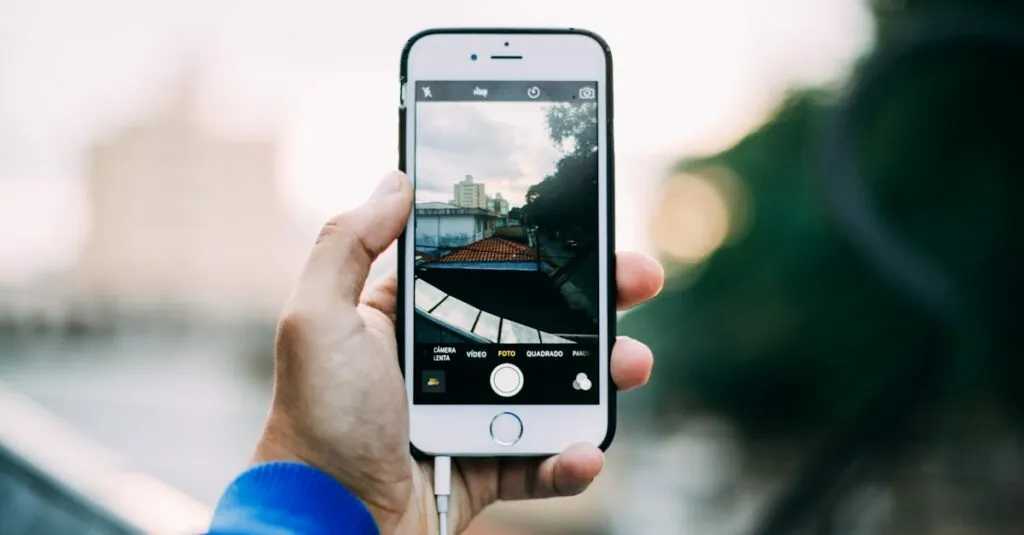Table of Contents
ToggleCapturing the moon with an iPhone 14 Pro might sound like a cosmic challenge, but it’s easier than trying to find a parking spot at a crowded mall. With its impressive camera capabilities, this smartphone can turn even the most amateur photographer into a lunar artist. Imagine impressing your friends with stunning moon shots that make it look like you’ve just returned from a space mission.
In just a few simple steps, you can snap a picture that’ll have everyone wondering if you’ve got a secret telescope hidden in your pocket. So grab your iPhone, step outside, and get ready to shoot the moon—literally! Whether you’re aiming for a close-up or a wide shot, this guide will help you unleash your inner astrophotographer without needing a degree in astronomy.
Understanding The iPhone 14 Pro Camera Features
The iPhone 14 Pro boasts advanced camera features ideal for capturing detailed lunar images. Knowledge of its specifications enhances the photography experience.
Camera Specifications
The main camera includes a 48MP wide sensor. This high-resolution sensor captures intricate details of the moon’s surface. Telephoto capabilities offer 3x optical zoom, enabling more precise shots without losing detail. Additionally, the ultra-wide lens provides a field of view perfect for creative compositions. Smart HDR 4 improves dynamic range in challenging lighting, ensuring that shadows and highlights appear balanced. ProRAW and ProRes formats allow for greater editing flexibility, catering to enthusiasts who want to refine images post-capture.
Night Mode Capabilities
Night mode automatically activates in low-light settings, optimizing camera performance for night skies. This feature utilizes longer exposure times to brighten images without introducing excessive noise. Photonic Engine enhances detail retention and color accuracy, making moon shots vivid. The improved image processing applies to photos taken in dim conditions, allowing clearer visuals of lunar features. Users can stabilize their shots using Night mode, which mitigates blurriness often caused by movement. This functionality enables amateur photographers to achieve stunning nighttime results effortlessly.
Preparing For The Perfect Moonshot
Preparation plays a crucial role in capturing stunning moon photographs with the iPhone 14 Pro. Identifying the best location and timing enhances the quality of moon images significantly.
Selecting The Right Location
Choosing an optimal site can make all the difference in photo quality. Look for places with minimal light pollution; this improves visibility. Parks, nature reserves, or locations away from city lights offer ideal settings. Consider a vantage point that provides a clear view of the horizon. Elevation can also enhance perspectives, helping to capture more detail. Open spaces allow for creative compositions, emphasizing the moon against the night sky.
Best Time To Take Photographs
Timing impacts the attributes of moon photographs significantly. Photographers should aim for a night when the moon is in a phase conducive to detail, such as the waxing gibbous or full moon. Additionally, the golden hour, which occurs shortly after sunset or before sunrise, can soften lighting conditions and enhance colors. Avoid taking photographs when the moon is low on the horizon, as atmospheric interference may reduce clarity. Clear nights offer optimum conditions, allowing for sharper and more vibrant images.
Setting Up Your iPhone 14 Pro
Setting up the iPhone 14 Pro for moon photography involves accessing the right features and preparing the device properly. Optimizing settings ensures stunning lunar shots, ensuring enthusiasts capture every detail.
Using The Native Camera App
Using the native camera app provides a straightforward way to snap moon photos. Access the app and select Photo mode for easy use. Switching to Night mode enhances low-light performance, allowing the camera to intelligently adjust settings for clearer images. The 3x optical zoom feature creates sharp, close-up shots of the moon. Familiarizing with the camera layout lets users switch between lenses seamlessly.
Adjusting Exposure And Focus
Adjusting exposure and focus plays a crucial role in capturing excellent images of the moon. Tapping on the screen directly will set the focus on the lunar surface. After this, sliding the exposure control up or down fine-tunes brightness. Lowering exposure prevents glare and enhances detail in brighter areas of the moon. This combination provides more vibrant and realistic moon photos while ensuring photographers achieve clearer results.
Tips For Capturing Stunning Moon Images
Capturing stunning images of the moon requires specific techniques and tools. Employing the right strategies can significantly enhance the quality of photos taken with the iPhone 14 Pro.
Utilizing Zoom Options
Using the iPhone 14 Pro’s zoom features optimizes lunar photography. Activate the 3x optical zoom for close-up shots, which reveals intricate lunar details. One can also experiment with digital zoom, although it may affect image quality. While zooming in, stability is crucial; using a tripod or resting the phone on a stable surface helps maintain clarity. Adjusting focus manually on the moon ensures sharper images, enhancing texture and contrast. The combination of zoom and focus control creates impressive close-up moon outcomes.
Exploring Third-Party Camera Apps
Third-party camera apps offer unique features that improve moon photography. Apps like NightCap and ProCamera provide advanced controls, including manual settings for ISO and shutter speed. These apps allow for longer exposure times and adjustable focus, essential for low-light conditions. Users can also save images in RAW format for superior editing flexibility. Experimenting with these apps can yield various results based on personal preferences and shooting conditions. Exploring different applications expands creative options and enhances the overall photographic experience.
Post-Processing Your Moon Photos
Post-processing enhances the beauty of moon photos taken with the iPhone 14 Pro, allowing photographers to refine their images for maximum impact. The editing process can transform a good shot into an extraordinary one.
Editing Tools and Techniques
Photo editing software like Adobe Lightroom and Snapseed provides powerful tools to adjust exposure, contrast, and clarity. These programs enhance lunar details, ensuring textures stand out. Users can also crop images to eliminate distracting elements, focusing attention on the moon. Applying filters may add artistic flair while maintaining the natural look. Experimenting with sharpening tools fine-tunes edges, making craters more defined. Saving images in formats like JPEG or TIFF ensures quality retention for sharing or printing.
Sharing Your Images
Once edited, sharing moon photos on social media platforms like Instagram or Facebook showcases the breathtaking results to a wider audience. Tagging relevant communities increases visibility, attracting fellow photography enthusiasts. Utilizing hashtags such as #moonphotography and #astrophotography connects images with like-minded individuals. Storing images in cloud services offers easy access, enabling quick sharing across devices. Engaging with followers by responding to comments fosters a supportive community around photography. Creating albums or galleries categorizes shots, making it easier to revisit cherished memories.
Capturing the moon with an iPhone 14 Pro is an exciting adventure that anyone can embark on. With the right techniques and settings, even those new to photography can achieve stunning results. The combination of advanced camera features and thoughtful preparation makes it possible to create images that truly showcase the moon’s beauty.
By selecting ideal locations and times, utilizing the iPhone’s impressive capabilities, and exploring post-processing options, photographers can elevate their moon shots to new heights. Sharing these images on social media not only highlights personal achievements but also connects enthusiasts across the globe. Embracing this creative journey can lead to breathtaking lunar photography that inspires others.







